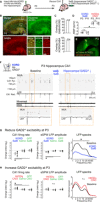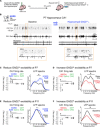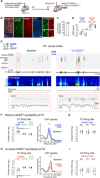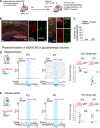GABAergic interneurons excite neonatal hippocampus in vivo
- PMID: 32582852
- PMCID: PMC7292633
- DOI: 10.1126/sciadv.aba1430
GABAergic interneurons excite neonatal hippocampus in vivo
Abstract
GABAergic interneurons are proposed to be critical for early activity and synapse formation by directly exciting, rather than inhibiting, neurons in developing hippocampus and neocortex. However, the role of GABAergic neurons in the generation of neonatal network activity has not been tested in vivo, and recent studies have challenged the excitatory nature of early GABA. By locally manipulating interneuron activity in unanesthetized neonatal mice, we show that GABAergic neurons are excitatory in CA1 hippocampus at postnatal day 3 (P3) and are responsible for most of the spontaneous firing of pyramidal cells at that age. Hippocampal interneurons become inhibitory by P7, whereas visual cortex interneurons are already inhibitory by P3 and remain so throughout development. These regional and age-specific differences are the result of a change in chloride reversal potential, because direct activation of light-gated anion channels in glutamatergic neurons drives CA1 firing at P3, but silences it at P7 in CA1, and at all ages in visual cortex. This study in the intact brain reveals that GABAergic interneuron excitation is essential for network activity in neonatal hippocampus and confirms that visual cortical interneurons are inhibitory throughout early postnatal development.
Copyright © 2020 The Authors, some rights reserved; exclusive licensee American Association for the Advancement of Science. No claim to original U.S. Government Works. Distributed under a Creative Commons Attribution NonCommercial License 4.0 (CC BY-NC).
Figures




Similar articles
-
An Optogenetic Approach for Investigation of Excitatory and Inhibitory Network GABA Actions in Mice Expressing Channelrhodopsin-2 in GABAergic Neurons.J Neurosci. 2016 Jun 1;36(22):5961-73. doi: 10.1523/JNEUROSCI.3482-15.2016. J Neurosci. 2016. PMID: 27251618 Free PMC article.
-
Neuromodulation of fast-spiking and non-fast-spiking hippocampal CA1 interneurons by human cerebrospinal fluid.J Physiol. 2016 Feb 15;594(4):937-52. doi: 10.1113/JP271553. Epub 2016 Jan 18. J Physiol. 2016. PMID: 26634295 Free PMC article.
-
The critical role of persistent sodium current in hippocampal gamma oscillations.Neuropharmacology. 2020 Jan 1;162:107787. doi: 10.1016/j.neuropharm.2019.107787. Epub 2019 Sep 21. Neuropharmacology. 2020. PMID: 31550457 Free PMC article.
-
Principles of GABAergic signaling in developing cortical network dynamics.Cell Rep. 2022 Mar 29;38(13):110568. doi: 10.1016/j.celrep.2022.110568. Cell Rep. 2022. PMID: 35354036 Review.
-
Cajal-Retzius cells and GABAergic interneurons of the developing hippocampus: Close electrophysiological encounters of the third kind.Brain Res. 2018 Oct 15;1697:124-133. doi: 10.1016/j.brainres.2018.07.028. Epub 2018 Jul 30. Brain Res. 2018. PMID: 30071194 Free PMC article. Review.
Cited by
-
Step by step: cells with multiple functions in cortical circuit assembly.Nat Rev Neurosci. 2022 Jul;23(7):395-410. doi: 10.1038/s41583-022-00585-6. Epub 2022 Apr 14. Nat Rev Neurosci. 2022. PMID: 35422526 Review.
-
Gabaergic Interneurons in Early Brain Development: Conducting and Orchestrated by Cortical Network Activity.Front Mol Neurosci. 2022 Jan 3;14:807969. doi: 10.3389/fnmol.2021.807969. eCollection 2021. Front Mol Neurosci. 2022. PMID: 35046773 Free PMC article.
-
cFOS as a biomarker of activity maturation in the hippocampal formation.Front Neurosci. 2023 Jul 13;17:929461. doi: 10.3389/fnins.2023.929461. eCollection 2023. Front Neurosci. 2023. PMID: 37521697 Free PMC article.
-
The Na+-activated K+ channel Slack contributes to synaptic development and plasticity.Cell Mol Life Sci. 2021 Dec;78(23):7569-7587. doi: 10.1007/s00018-021-03953-0. Epub 2021 Oct 18. Cell Mol Life Sci. 2021. PMID: 34664085 Free PMC article.
-
Dysregulation of GABAergic Signaling in Neurodevelomental Disorders: Targeting Cation-Chloride Co-transporters to Re-establish a Proper E/I Balance.Front Cell Neurosci. 2022 Jan 5;15:813441. doi: 10.3389/fncel.2021.813441. eCollection 2021. Front Cell Neurosci. 2022. PMID: 35069119 Free PMC article. Review.
References
-
- Le Magueresse C., Monyer H., GABAergic interneurons shape the functional maturation of the cortex. Neuron 77, 388–405 (2013). - PubMed
-
- Duan Z. R. S., Che A., Chu P., Modol L., Bollmann Y., Babij R., Fetcho R. N., Otsuka T., Fuccillo M. V., Liston C., Pisapia D. J., Cossart R., De Marco García N. V., GABAergic restriction of network dynamics regulates interneuron survival in the developing cortex. Neuron 105, 75–92.e5 (2020). - PMC - PubMed
-
- Marques-Smith A., Lyngholm D., Kaufmann A.-K., Stacey J. A., Hoerder-Suabedissen A., Becker E. B. E., Wilson M. C., Molnár Z., Butt S. J. B., A transient translaminar gabaergic interneuron circuit connects thalamocortical recipient layers in neonatal somatosensory cortex. Neuron 89, 536–549 (2016). - PMC - PubMed
Publication types
MeSH terms
Grants and funding
LinkOut - more resources
Full Text Sources
Other Literature Sources
Molecular Biology Databases
Research Materials
Miscellaneous

